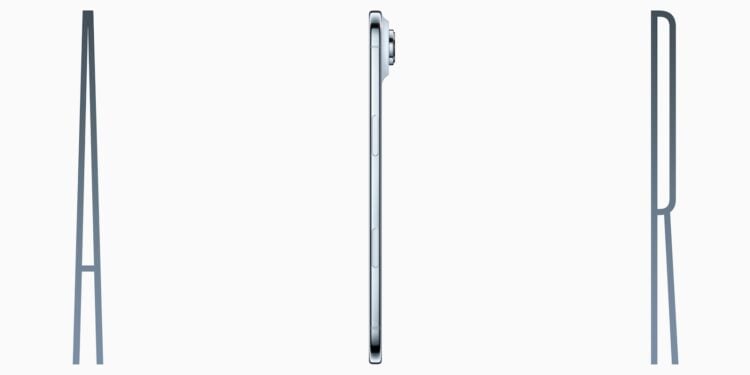The iPhone Air is the focus of a new interview conducted by the Wall Street Journal with Apple CEO Tim Cook and design chiefs Molly Anderson and Alan Dye. In it, the executives explain how Apple is positioning the iPhone Air, the decisions behind its design, and its role alongside the Pro line. Their statements also leave room for speculation about the future—including a possible foldable iPhone.
In recent years, Apple has focused on more clearly separating its iPhone portfolio. With its Pro models, the company targets power users, while its standard iPhones appeal to a broader audience. The iPhone Air now takes on a new role: extremely thin, light, and strongly focused on design and lifestyle. Tim Cook and his team members describe it as a device defined less by pure performance than by the way it feels when worn and used.
An iPhone for the “Ozempic Era”
The Wall Street Journal calls the iPhone Air "an iPhone for the Oceanic era." While this comparison may seem unusual, it demonstrates Apple's strong emphasis on lightweight design and minimalism. The iPhone Air is intended to be less of a workhorse and more of a statement that consciously emphasizes elegance.
Materials and surface
A central theme in the interview is the choice of materials. Unlike the Pro models, which have a more textured appearance, the iPhone Air features a highly polished surface. According to Molly Anderson, this effect contributes to the device's appearance, making it appear even thinner. At the same time, it's intended to create a more distinctive look. Anderson explains that the glossy surface conveys a different perception of what a smartphone is and how it's worn.
Air or Pro – the difficult decision
Apple itself admits that users have to weigh things up when choosing between the iPhone Air and the iPhone Pro. Anderson deliberately describes the decision as difficult. The Pro model is tailored to photographers, filmmakers, and content creators and offers unique visual features, such as colors like "cosmic orange." The iPhone Air, on the other hand, emphasizes lightness, style, and the freedom of carrying less weight. Both models have clear strengths—and it's precisely this differentiation that should make them so appealing.
Room for speculation
Naturally, the question of a possible foldable iPhone also came up in the interview. When asked directly whether the iPhone Air was an intermediate step in that direction, Tim Cook simply replied:
We're really good at keeping secrets.
He declined to provide any concrete answer, but instead shifted the focus back to the current announcement. Nevertheless, speculation is that Apple is using the iPhone Air to gain experience on how to efficiently produce an extremely thin case. A comparison with the Samsung Fold 7 makes the possible background clear: The latter is 8.9 millimeters thin when closed and only 4.2 millimeters when opened—a benchmark against which Apple could be measured in the future.
Accessories as part of the concept
In addition to technical and design issues, accessories also played a role. Apple introduced the crossbody strap accessory, which allows the iPhone Air to be worn on the body. Tim Cook emphasized that this is a way to express one's own personality more fully. Since the iPhone has long been a constant companion for many, it should be not only functional but also a style-defining object.
iPhone Air: More than just a lightweight alternative
The iPhone Air is more than just a slimmed-down version of the Pro models. It's Apple's attempt to establish an ultra-thin, lightweight, and stylish smartphone that captures the spirit of the times. With its polished finish, lifestyle focus, and reimagined accessories, it clearly stands out from the Pro lineup. At the same time, it raises questions about whether Apple is laying the foundation for a foldable iPhone. One thing is certain: The iPhone Air adds a new dimension to the iPhone family, putting design and everyday experience at the center. (Image: Apple)
- Apple and politics: New allegations surrounding AI guidelines
- Live translation remains blocked in Europe for the time being
- Apple remains market leader in the premium segment despite competition
- Apple allegedly trained AI with pirated software: Authors sue
- MacBook Pro 2026: Apple plans major upgrade with OLED
- Apple remains market leader in the premium segment despite competition
- Apple launches new MagSafe charger with Qi2 25W support
- iPhone 17 and 5G: mmWave remains reserved for US users
- AirPods Pro 3: Surprise discovered in battery life
- iPhone 17: Differences between A19 and A19 Pro
- iPhone Air weight: Comparison of all current Apple models
- iPhone 17: Apple brings significantly longer battery life
- iPhone 17: Apple introduces groundbreaking security feature
- iPhone 17: Dual Capture Video now directly in the Camera app
- macOS 26 brings repair assistant for calibration & parts
- iPhone Air with C1X modem – faster, more efficient, better
- iPhone 17 Pro uses aluminum – all the reasons in detail
- iPhone 17: N1 chip, more RAM and battery life at a glance
- High blood pressure warnings coming to older Apple Watch models
- AirPods Pro 2 and AirPods 4 get live translation feature
- MagSafe battery exclusively for iPhone Air – iPhone 17 runs out of power
- New iPhone accessories 2025: cases, bumpers and crossbody
- Final Cut Camera 2.0: All new features at a glance
- iPhone Air battery life: Comparison with iPhone 17 and predecessors
- iPhone 17: There is no longer a SIM slot in these countries





